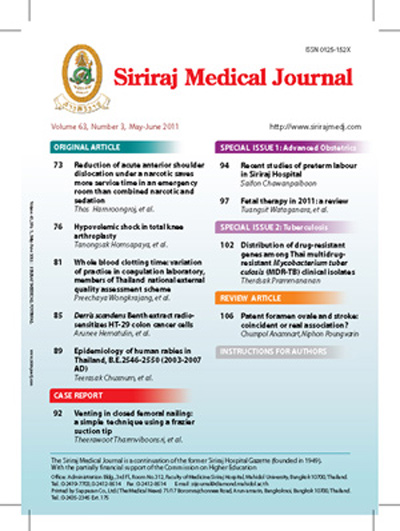Epidemiology of Human Rabies in Thailand, B.E.2546-2550 (2003-2007 AD)
Keywords:
Human; rabies; epidemiology; ThailandAbstract
In Thailand, rabies remains an important zoonotic disease due to its lethality in humans. Although the numbers of
human rabies cases have been steadily decreasing over the past ten years, the epidemiological situation has started to change.
Assessment of human rabies was based on the national infectious disease surveillance system from B.E. 2546-2550. There were
106 cumulative cases distributed in all four regions of Thailand. The highest mortality rates were found in the Central and
Southern regions. Dogs were the main reservoir with the highest percentage found in puppies younger than 3 months (45%).
Most of the causal dogs, and 61% of the dogs with owners had not received Rabies vaccination each year. The data strongly
revealed that most of the human rabies cases did not receive rabies vaccine after the animal contact or bite. Prevention and
control strategies should focus especially on the regions and provinces which had the highest number of cases, or on those
regions which continue to have incident cases each year. It is also essential to set up a better control of the animal population
which can potentially infect humans.
References
2. Bureau of Epidemiology, Ministry of Public Health. Communicable disease case definition. 2nd ed. Nonthaburi, Bureau of Epidemiology; 2003.
Downloads
Published
How to Cite
Issue
Section
License
Authors who publish with this journal agree to the following conditions:
Copyright Transfer
In submitting a manuscript, the authors acknowledge that the work will become the copyrighted property of Siriraj Medical Journal upon publication.
License
Articles are licensed under a Creative Commons Attribution-NonCommercial-NoDerivatives 4.0 International License (CC BY-NC-ND 4.0). This license allows for the sharing of the work for non-commercial purposes with proper attribution to the authors and the journal. However, it does not permit modifications or the creation of derivative works.
Sharing and Access
Authors are encouraged to share their article on their personal or institutional websites and through other non-commercial platforms. Doing so can increase readership and citations.











